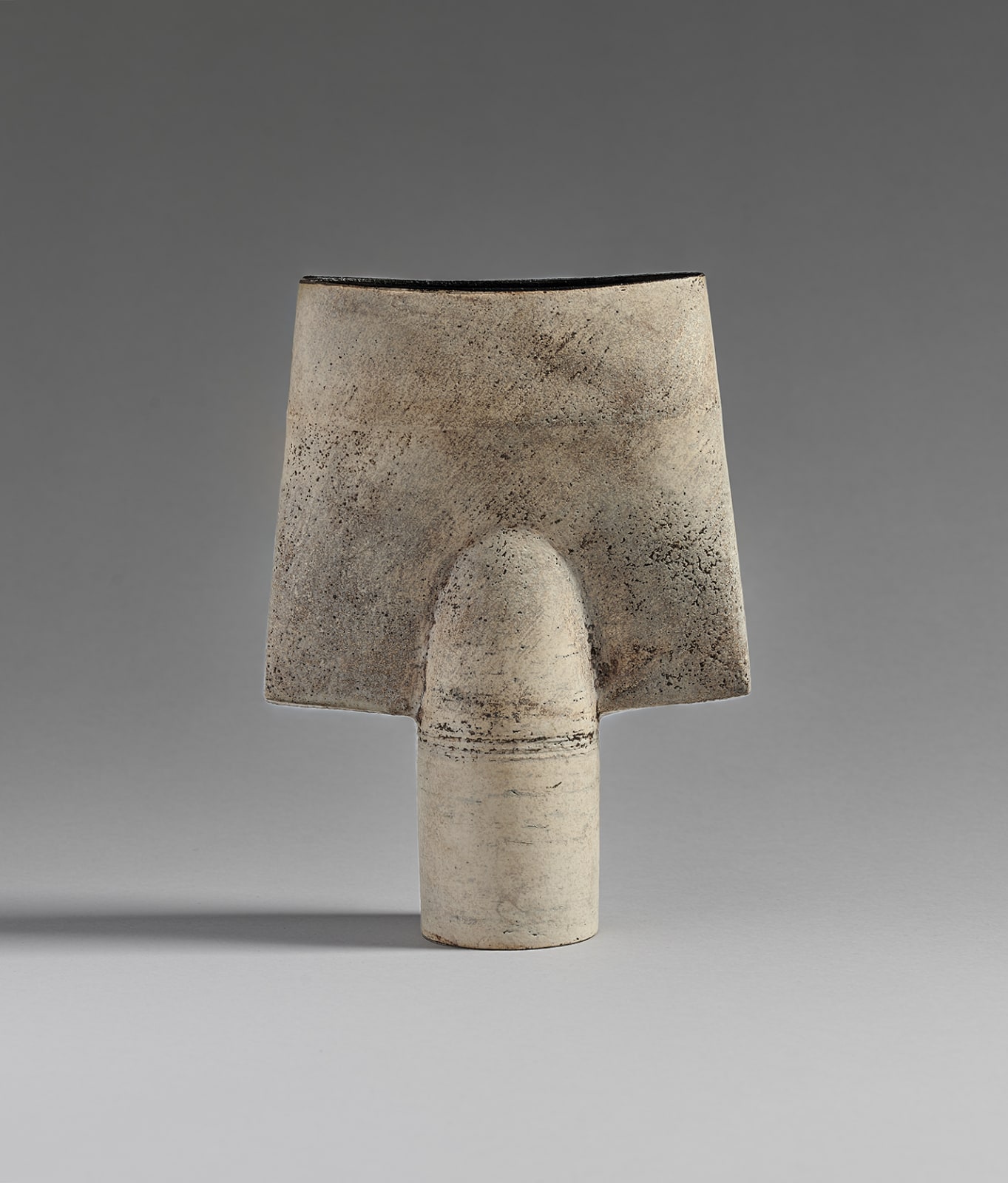Hans Coper 1920-1981
Spade form, 1972
stoneware, layered white porcelain slips and engobes over a body with textured and incised linear designs, the interior with manganese glaze
height 8 1/4 inches / 21 cm
impressed with artist’s seal
Further images
Hans Coper’s work was, among other things, about a studied honing down of form, what he called ‘concentrating on continuous variations of simple themes’, making shapes that were thrown, altered...
Hans Coper’s work was, among other things, about a studied honing down of form, what he called ‘concentrating on continuous variations of simple themes’, making shapes that were thrown, altered and assembled. They were objects that reinvented the wheel, or more precisely, they helped to reinvent the modern language of the potter’s wheel, developing the idea that throwing was just one part of the making process. He admired artists like Brâncuşi and Giacometti in part because of their ability to express a sculptural essence. Their approaches to the pared-down figure were attractive to a potter drawn to concentration. Coper’s principal tool would always be the wheel, but this superb piece demonstrates how he was able to broaden the vocabulary of throwing through post-wheel manipulation, of cutting and joining thrown sections.
The ‘Spade Form‘ – this example is from 1972 – was developed in the mid-1960s when Coper was living and working in Hammersmith. This shape was first exhibited in his important show with Lucie Rie at Museum Boijmans in Rotterdam in 1967. With its narrow cylindrical base opening out into a broader, flattened cylinder, tapering slightly towards the rim, it was suggestive of a very abstracted and summarised head and neck. There were references to the frontality and simplicity of Cycladic figures and Egyptian sculpture, but the fact that they were still pots, having risen first as vessels on the turning wheel, was important.
Douglas Hill wrote perceptively (and with Coper’s approval) in the catalogue for the Boijmans exhibition, ‘In Coper’s work, one can see not so much a quality of serenity as a kind of balanced tension. Coper seems to be exploring the outward limits of pottery, and to be pushing those limits back with each motif.’ The ‘Spade Forms‘ showed Coper’s continuing preoccupation with symmetry and balance, the sense of a piece having perfectly integrated parts. In examining earlier and later variations of his pots, we realise how closely related each development is, how the ‘Spade’ grew out of earlier stem pieces and cups, part of the same family of contemporaneous disc forms, hourglass shapes and the narrow forms on drum bases. This ‘Spade‘ piece is a striking example of how Coper distilled from history, epitomising his process of, as he put it, ‘extracting essences’. On one level, it has that hard-achieved simplicity, but it also has a votive presence, an almost hieratic quality, one that gives Coper’s best work that all-pervasive mystery.
Text by David Whiting
The ‘Spade Form‘ – this example is from 1972 – was developed in the mid-1960s when Coper was living and working in Hammersmith. This shape was first exhibited in his important show with Lucie Rie at Museum Boijmans in Rotterdam in 1967. With its narrow cylindrical base opening out into a broader, flattened cylinder, tapering slightly towards the rim, it was suggestive of a very abstracted and summarised head and neck. There were references to the frontality and simplicity of Cycladic figures and Egyptian sculpture, but the fact that they were still pots, having risen first as vessels on the turning wheel, was important.
Douglas Hill wrote perceptively (and with Coper’s approval) in the catalogue for the Boijmans exhibition, ‘In Coper’s work, one can see not so much a quality of serenity as a kind of balanced tension. Coper seems to be exploring the outward limits of pottery, and to be pushing those limits back with each motif.’ The ‘Spade Forms‘ showed Coper’s continuing preoccupation with symmetry and balance, the sense of a piece having perfectly integrated parts. In examining earlier and later variations of his pots, we realise how closely related each development is, how the ‘Spade’ grew out of earlier stem pieces and cups, part of the same family of contemporaneous disc forms, hourglass shapes and the narrow forms on drum bases. This ‘Spade‘ piece is a striking example of how Coper distilled from history, epitomising his process of, as he put it, ‘extracting essences’. On one level, it has that hard-achieved simplicity, but it also has a votive presence, an almost hieratic quality, one that gives Coper’s best work that all-pervasive mystery.
Text by David Whiting
Provenance
Fischer Fine Art, LondonPrivate Collection, UK, acquired from the above in 1972





